
Ursidae is a family of mammals in the order Carnivora, which includes the giant panda, brown bear, and polar bear, and many other extant or extinct mammals. A member of this family is called a bear or an ursid. They are widespread across the Americas and Eurasia. Bear habitats are generally forests, though some species can be found in grassland and savana regions, and the polar bear lives in arctic and aquatic habitats. Most bears are 1.2–2 m (4–7 ft) long, plus a 3–20 cm (1–8 in) tail, though the polar bear is 2.2–2.44 m (7–8 ft) long, and some subspecies of brown bear can be up to 2.8 m (9 ft). Weights range greatly from the sun bear, which can be as low as 35 kg (77 lb), to the polar bear, which can be as high as 726 kg (1,600 lb). Population sizes vary, with six species classified as vulnerable with populations as low as 500, while the brown bear has a population of over 100,000 and the American black bear around 800,000. Many bear species primarily eat specific foods, such as seals for the polar bear or termites and fruit for the sloth bear, but with the exception of the giant panda, which exclusively eats bamboo, ursids are omnivorous when necessary. No ursid species have been domesticated, though some bears have been trained for entertainment.[1]
The eight species of Ursidae are split into five genera in three subfamilies: the monotypic Ailuropodinae, the panda bears; Tremarctinae, the short-faced bears; and Ursinae, containing all other extant bears. Extinct species have also been placed into all three extant subfamilies, as well as three extinct ones: Agriotheriinae, Hemicyoninae, and Ursavinae. Over 100 extinct Ursidae species have been found, though due to ongoing research and discoveries the exact number and categorization is not fixed.
Conventions
| Conservation status | |
|---|---|
| EX | Extinct (0 species) |
| EW | Extinct in the wild (0 species) |
| CR | Critically Endangered (0 species) |
| EN | Endangered (0 species) |
| VU | Vulnerable (6 species) |
| NT | Near threatened (0 species) |
| LC | Least concern (2 species) |
Conservation status codes listed follow the International Union for Conservation of Nature (IUCN) Red List of Threatened Species. Ranges are based on the IUCN Red List for that species unless otherwise noted. All extinct species or subspecies listed alongside extant species went extinct after 1500 CE, and are indicated by a dagger symbol "†". Population figures are rounded to the nearest hundred.
Classification
The family Ursidae consists of eight extant species belonging to five genera in three subfamilies and divided into dozens of extant subspecies. This does not include ursid hybrid species such as grizzly–polar bear hybrids or extinct prehistoric species.
- Subfamily Ailuropodinae
- Genus Ailuropoda (panda bears): one species
- Subfamily Tremarctinae
- Genus Tremarctos (short-faced bears): one species
- Subfamily Ursinae
Ursids
The following classification is based on the taxonomy described by Mammal Species of the World (2005), with augmentation by generally accepted proposals made since using molecular phylogenetic analysis; this includes the division of the giant panda into two subspecies. There are several additional proposals which are disputed, such as reclassifying the subspecies of the brown bear into a smaller set of clades,[2][3] which are not included here.
Subfamily Ailuropodinae
| Common name | Scientific name and subspecies | Range | Size and ecology | IUCN status and estimated population |
|---|---|---|---|---|
| Giant panda
|
A. melanoleuca (David, 1869) Two subspecies
|
Central China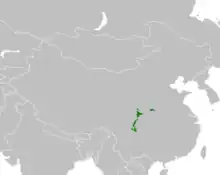 |
Size: 150–180 cm (59–71 in) long, plus 10–15 cm (4–6 in) tail 80–123 kg (176–271 lb)[4][5] Habitat: Forest[6] Diet: Eats only bamboo[6] |
VU
|
Subfamily Tremarctinae
| Common name | Scientific name and subspecies | Range | Size and ecology | IUCN status and estimated population |
|---|---|---|---|---|
| Spectacled bear
|
T. ornatus (F. Cuvier, 1825) |
Andes mountains in South America |
Size: 120–200 cm (47–79 in) long, plus 7 cm (3 in) tail 60–175 kg (132–386 lb)[7] Habitat: Shrubland, grassland, and forest[8] Diet: Primarily eats bromeliads and palm trees, as well as cattle, other mammals, and fruit[8] |
VU
|
Subfamily Ursinae
| Common name | Scientific name and subspecies | Range | Size and ecology | IUCN status and estimated population |
|---|---|---|---|---|
| Sun bear
|
H. malayanus (Raffles, 1821) Two subspecies
|
Southeast Asia (current range in brown, former in black)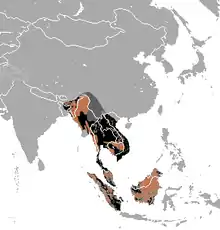 |
Size: 120–150 cm (47–59 in) long, plus 3–7 cm (1–3 in) tail 35–80 kg (77–176 lb)[9][10] Habitat: Forest and shrubland[11] Diet: Primarily eats termites, ants, beetle larvae, bee larvae, honey, and fruit[11] |
VU |
| Common name | Scientific name and subspecies | Range | Size and ecology | IUCN status and estimated population |
|---|---|---|---|---|
| Sloth bear
|
M. ursinus (Shaw, 1791) Two subspecies
|
India (current range in green, former in black) |
Size: 150–180 cm (59–71 in) long, plus 7–12 cm (3–5 in) tail 54–141 kg (119–311 lb)[13] Habitat: Shrubland, grassland, forest, and savanna[14] Diet: Primarily eats termites and fruit[14] |
VU |
| Common name | Scientific name and subspecies | Range | Size and ecology | IUCN status and estimated population |
|---|---|---|---|---|
| American black bear
|
U. americanus Pallas, 1780 Sixteen subspecies
|
North America (current range in red, former in pink) |
Size: 120–200 cm (47–79 in) long, plus 8–14 cm (3–6 in) tail 39–409 kg (86–902 lb)[16] Habitat: Forest, inland wetlands, grassland, shrubland, and desert[17] Diet: Omnivorous; eats vegetation, roots, buds, fruit, nuts, insects, fish, mammals, and carrion[17] |
LC |
| Asian black bear
|
U. thibetanus Cuvier, 1823 Seven subspecies
|
South and East Asia (current range in brown, former in black)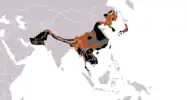 |
Size: 120–180 cm (47–71 in) long, plus 6–11 cm (2–4 in) tail 65–150 kg (143–331 lb)[19] Habitat: Forest, inland wetlands, grassland, and shrubland[20] Diet: Eats vegetation, insects, fruit, nuts, ungulates, and livestock[20] |
VU |
| Brown bear
|
U. arctos Linnaeus, 1758 Sixteen subspecies
|
Northern North America and Europe, and northern and central Asia |
Size: 100–280 cm (39–110 in) long, plus 6–20 cm (2–8 in) tail 80–550 kg (176–1,213 lb)[21] Habitat: Desert, forest, inland wetlands, grassland, and shrubland[22] Diet: Omnivorous; eats grasses, herbs, roots, berries, nuts, insects, mammals, and fish[22] |
LC
|
| Polar bear
|
U. maritimus Mulgrave, 1774 |
Polar North America and Asia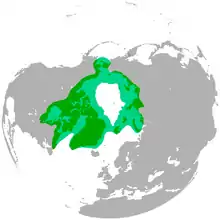 |
Size: 220–244 cm (87–96 in) long, plus 7–13 cm (3–5 in) tail 408–726 kg (900–1,600 lb)[23] Habitat: Marine oceanic, shrubland, forest, grassland, marine coastal/supratidal, and marine intertidal[24] Diet: Primarily eats seals, as well as walruses, beluga whales, birds, fish, vegetation and kelp[24] |
VU |
See also
References
- ↑ Findeizen, Nikolai (2008). History of Music in Russia from Antiquity to 1800, Vol. 1: From Antiquity to the Beginning of the Eighteenth Century. Indiana University Press. p. 201. ISBN 978-0-253-02637-8.
- ↑ Calvignac, S.; Hughes, S.; Tougard, C.; Michaux, J.; Thevenot, M.; Philippe, M.; Hamdine, W.; Hanni, C. (2008). "Ancient DNA evidence for the loss of a highly divergent brown bear clade during historical times" (PDF). Molecular Ecology. 17 (8): 1962–1970. doi:10.1111/j.1365-294x.2008.03631.x. PMID 18363668. S2CID 23361337.
- ↑ Lan, T.; Gill, S.; Bellemain, E.; Bischof, R.; Zawaz, M. A.; Lindqvist, C. (2017). "Evolutionary history of enigmatic bears in the Tibetan Plateau–Himalaya region and the identity of the yeti". Proceedings of the Royal Society B: Biological Sciences. 284 (1868): 20171804. doi:10.1098/rspb.2017.1804. PMC 5740279. PMID 29187630.
- ↑ Bies, LeeAnn (2002). "Ailuropoda melanoleuca". Animal Diversity Web. University of Michigan. Retrieved March 24, 2020.
- ↑ "Physical Description". Knowledge Hub. World Wide Fund for Nature. Retrieved March 24, 2020.
- 1 2 3 Swaisgood, R.; Wang, D.; Wei, F. (2017) [errata version of 2016 assessment]. "Ailuropoda melanoleuca". IUCN Red List of Threatened Species. 2016: e.T712A121745669.
- ↑ "Spectacled bear (Tremarctos ornatus)". ARKive. Wildscreen. Archived from the original on June 14, 2017. Retrieved March 25, 2020.
- 1 2 3 Velez-Liendo, X.; García-Rangel, S. (2018) [errata version of 2017 assessment]. "Tremarctos ornatus". IUCN Red List of Threatened Species. 2017: e.T22066A45034047. doi:10.2305/IUCN.UK.2017-3.RLTS.T22066A45034047.en.
- ↑ "Malayan sun bear (Helarctos malayanus)". ARKive. Wildscreen. Archived from the original on December 21, 2014. Retrieved March 26, 2020.
- ↑ Brown, Gary (February 1996). Great Bear Almanac. The Lyons Press. p. 340. ISBN 978-1-55821-474-3.
- 1 2 3 Scotson, L.; Fredriksson, G.; Augeri, D.; Cheah, C.; Ngoprasert, D.; Wai-Ming, W. (2018) [errata version of 2017 assessment]. "Helarctos malayanus". IUCN Red List of Threatened Species. 2017: e.T9760A45033547. doi:10.2305/IUCN.UK.2017-3.RLTS.T9760A45033547.en.
- 1 2 Dickson, B. (November 5, 2013). Endangered Species Threatened Convention. Routledge. p. 82. ISBN 978-1-134-19434-6.
- ↑ "Sloth Bear". The Photo Ark. National Geographic. 12 March 2010. Archived from the original on March 11, 2017. Retrieved March 24, 2020.
- 1 2 3 4 Dharaiya, N.; Bargali, H. S.; Sharp, T. (2020) [amended version of 2016 assessment]. "Melursus ursinus". IUCN Red List of Threatened Species. 2020: e.T13143A166519315. doi:10.2305/IUCN.UK.2020-1.RLTS.T13143A166519315.en.
- ↑ Ramesh, T.; Kalle, R.; Sankar, K.; Qureshi, Q. (2012). "Factors affecting habitat patch use by sloth bears in Mudumalai Tiger Reserve, Western Ghats, India". Ursus. 23 (1): 78–85. doi:10.2192/URSUS-D-11-00006.1. JSTOR 41818973. S2CID 86410436.
- ↑ Dewey, Tanya; Kronk, Christine (2007). "Ursus americanus". Animal Diversity Web. University of Michigan. Retrieved March 24, 2020.
- 1 2 3 Garshelis, D. L.; Scheick, B. K.; Doan-Crider, D. L.; Beecham, J. J.; Obbard, M. E. (2017) [errata version of 2016 assessment]. "Ursus americanus". IUCN Red List of Threatened Species. 2016: e.T41687A45034604. doi:10.2305/IUCN.UK.2016-3.RLTS.T41687A45034604.en.
- ↑ "Black Bear Study Finds Growing Populations, But Combating Illegal Trade Remains a Challenge". WWF News and Reports. World Wide Fund for Nature. April 30, 2002. Retrieved February 29, 2020.
- ↑ Goodness, Tracie (2004). "Ursus thibetanus". Animal Diversity Web. University of Michigan. Retrieved March 24, 2020.
- 1 2 3 Garshelis, D.; Steinmetz, R. (2017) [errata version of 2016 assessment]. "Ursus thibetanus". IUCN Red List of Threatened Species. 2016: e.T22824A45034242. doi:10.2305/IUCN.UK.2016-3.RLTS.T22824A45034242.en.
- ↑ "Brown Bear (Ursus arctos) Fact Sheet: Physical Characteristics". San Diego Zoo Global Library. San Diego Zoo. October 15, 2019. Retrieved March 26, 2020.
- 1 2 3 McLellan, B. N.; Proctor, M. F.; Huber, D.; Michel, S. (2017) [amended version of 2017 assessment]. "Ursus arctos". IUCN Red List of Threatened Species. 2017: e.T41688A121229971. doi:10.2305/IUCN.UK.2017-3.RLTS.T41688A121229971.en.
- ↑ "Polar Bear". The Photo Ark. National Geographic. September 10, 2010. Archived from the original on October 12, 2016. Retrieved March 24, 2020.
- 1 2 3 Wiig, Ø.; Amstrup, S.; Atwood, T.; Laidre, K.; Lunn, N.; Obbard, M.; Regehr, E.; Thiemann, G. (2015). "Ursus maritimus". IUCN Red List of Threatened Species. 2015: e.T22823A14871490. doi:10.2305/IUCN.UK.2015-4.RLTS.T22823A14871490.en.
- ↑ Hamilton, S. G.; Derocher, A. E. (2019). "Assessment of global polar bear abundance and vulnerability". Animal Conservation. 22 (1): 83–95. doi:10.1111/acv.12439. S2CID 92716329.



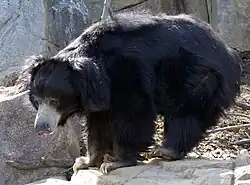

.JPG.webp)

.jpg.webp)